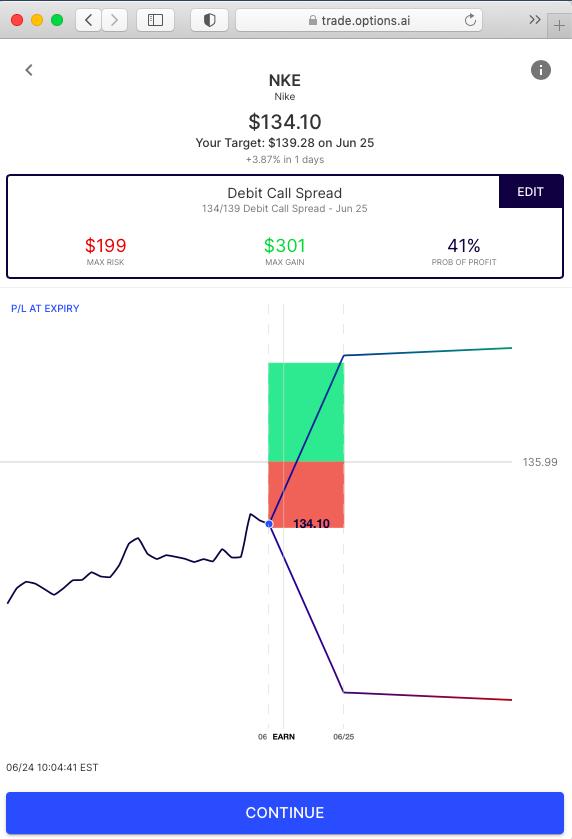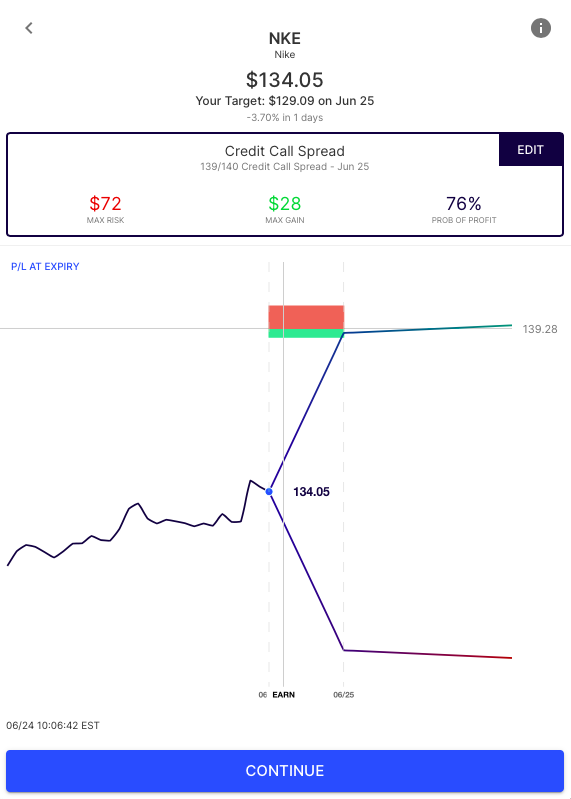Traders can quickly generate Credit Spread strategies on Options AI based around the expected move of a stock, a specific trading view, or on probability of breakeven. Below we’ll go over the dynamics of Credit Spreads, their risk/reward profiles and the different views a trader might express using this options strategy.
- Credit Spreads vs Debit Spreads
- Breakeven and Probability of Profit
- Risk/Reward
An easy way to understand Credit Spreads is that you are simply taking the other side of a Debit Spread. A Call or Put Debit Spread positions for a move, either up or down, and will have a breakeven that the stock needs to be above (in the case of a Debit Call Spread) or below (in the case of a Credit Put Spread) on expiration, in order to be profitable. In contrast, a Credit Spread positions against a stock moving beyond that breakeven. It is profitable if the stock stays inside that breakeven, and allows a trader to realize max. gain at expiry if the stock stays inside the short strike.
Here’s an example using Nike (NKE), a stock that reports earnings on Thursday, with options pricing about a 4% move (or ~$5) in either direction.
Debit Spread Recap – First we’ll look at a fairly simple $5 wide Debit Call Spread, a bullish trade that costs $2 and can make up $3 if Nike moves higher in line, or above, its bullish expected move:

This is a fairly easy to understand option trade. Risk $2, make up to $3. But the trader needs the stock to go up at least $2 to make money. And if the stock is at or below its long call strike (134) the trade expires worthless and the trader loses $2. In other words, the trade is bullish, and needs the stock to go higher, not only to make money but also to avoid losing money.
Selling the same spread at a Credit – Traders have multiple ways to express views in options. Let’s assume a trader is bearish, and wants to sell that same Call Spread – creating a bearish Credit Call Spread that has the inverse metrics of the bullish Debit Call Spread. Here’s the same Call Spread, but sold at a credit. Credit Call Spreads can be generated via the “I’m bearish” button on Options AI:

Note that the levels on the chart are identical. But in this case, the trader is selling the 134 call and buying the 139 call, and receiving a $2 credit. They risk up to $3 if the stock moves higher. But… if the stock is at or below the 134 call strike, the trade expires worthless, and the trader collects their max. profit (the $2 credit they received).
Put simply, the trader that bought the Call Spread for a debit needs the stock to go higher (above the breakeven) to profit, whereas the trader that sold the Call Spread for a credit is looking for the stock to stay below that breakeven.
Selling out of the money spreads – In the above comparison, the trader used an at-the-money Credit Call Spread to express a view but traders might also look to out-of-the-money credit spreads for higher probability of profit. The concept is the same, positioning against a move. But with an out-of-the-money credit spread, the trader is positioning against a large move in the stock.
One point to note: The trades are often high probability of profit, but the risk/reward ratio is worse than at-the-money, risking more to make less for the higher probability.
Here’s an example in NKE, with an out-of-the-money Credit Put Spread set at the expected move in the stock. In this case, the trader is “bullish” but it is more that they are expressing a view that even if Nike goes lower, it will not go sharply lower, below the bearish consensus:

In this example, the Credit Put Spread risks $25 to make $75. It has a high probability of profit (78%) but if the stock is below its lower strike (128) on tomorrow’s expiry it would lose $75. But, if Nike stock is at or above 129 (its upper strike) it would be max gain, collecting the entire $25 credit.
Note: An out-of-the-money credit spread positions against large moves, trading higher probability of profit for lower returns against what is risked.
Here’s a look at the out of the money Credit Call Spread, which looks to collect its entire credit if NKE is at or below 139 on expiry:

Selling the move entirely via Iron Condors – Credit Call and Put spreads position against something happening in one direction. They are bearish by not being bullish, or vice versa. But traders can also combine out of the money credit spreads to be completely agnostic on direction, and looking to collect a credit if a stock stays within a range.
Here’s an example of an Iron Condor. It combines the two out-of-the-money Credit Spreads from above. Iron Condors can be reached via the neutral button on Options AI:

This trade risks about $50 to make up to $50 if the stock does not make a large move in either direction. It collects around $25 from the sale of both the Credit Call and Credit Put spreads
The risk (or max loss), however, is not the combined max loss of each Credit Spread. That’s because the stock can only move in one direction or the other. One spread will be max gain regardless of what happens.
But also note the lower probability of profit of the Iron Condor vs an outright Credit Call or Put Spread. That’s because the stock can move in either direction, beyond the outer strike of either Credit Spread. And if the stock does move in either direction, beyond either spread, that means max loss for the entire trade.
Based upon publicly available information derived from option prices at the time of publishing. Intended for informational and educational purposes only and is not any form of recommendation of a particular security, strategy or to open a brokerage account. Options price data and past performance data should not be construed as being indicative of future results and do not guarantee future results or returns. Options involve risk, including exposing investors to potentially significant losses and are therefore not suitable for all investors. Option spreads involve additional risks that should be fully understood prior to investing. Securities trading is offered through Options AI Financial, LLC a registered broker-dealer.


